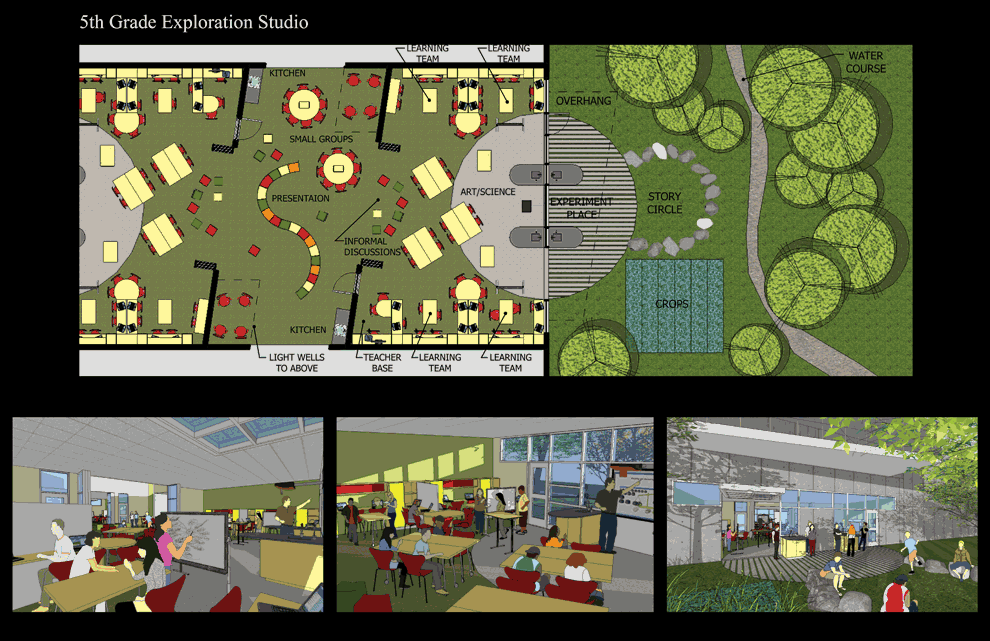
Perhaps this is a road to frustration, but over the next few posts, I'd like to look at some new models for schools and school buildings that apply what we have learned over the past 30 years or so about teaching and learning. By and large, a high school teacher from 1870 would be completely comfortable with the way I am expected to teach most of the time in most American schools: 1 teacher with 25 kids seated at desks, stuffed in a box for between 40 and 80 minutes in a time. We now know that this serves about 15% of the students in front of us well. The rest of them are either forced to try and adapt or spin their wheels, which can interfere with the process for me and the other students.
I am not delivering any news here, but I hope I can spread some of the ideas people are playing with to get teaching to line up with what we know about learning. Above is the winning entry in a competition by Slate.com to come up with new models for the 21st century classroom. The hallmark of this design is the variety and flexibility of the space. As the article points out, the space for a single classroom incorporates
adjustable furniture, a messy art area, video screens large and small, communal areas for classes to share, carefully placed mirrors that allow for eye contact when a student and teacher sit at a computer together. Trish Fineran, the teacher on our panel of judges, loved that the tables were on wheels. She loved the integration of spaces enabling solo work as well as large and small group projects.Check out some of the other leading proposals here. I hope I'll have the opportunity to highlight a few more from this competition, but first I want to get some other ideas from other sources in posts to follow.
In the meantime, I must still try and literally think outside of the box our 80-year-old high school buildings are made out of. I must try and make my plans more authentic, introduce more collaboration and capitalize on the skill sets and prior knowledge my students bring to the classroom. I don't know if my career will last to the day when we can fix these dreadful old buildings, but maybe I should pretend I'm already in one.





This comment has been removed by the author.
ReplyDeleteA very good friend sent this to my Facebook page:
ReplyDelete"We sent [our son] to Denmark for his 8th grade year because the traditional model for education in New York is very unkind to boys with ADD. We have family who live outside of Copenhagen. He spent a year in a classroom with 18 kids and 2 teachers who had been with this class since kindergarten. Teacher for science, math, and foreign language rotated into the room, so during those subjects there were 3 teachers available, the result being that those who had mastered a task were given something more challenging while those who needed more time to get the basics got the attention they needed. ([Our son] rotated out during foreign language to a Danish as a second language class -- German taught in Danish was a bit much for him)
"The class functioned like a family. If somebody forgot something they were told 'go home and get it' -- a natural consequence. Elementary schools in Denmark are generally neighborhood schools, and everyone either walks or bikes to school. During lunch the children could eat in the classroom, go outside, go home, or go down the street to the kebab stand. There was a sink in the classroom, with a shelf of cups and plates labeled with the students names for when they had parties or had a snack that was part of the lesson. He had maybe 20 minutes of homework a week. In Denmark children are children and it is felt that their play is a very crucial part of their growing up and social development.
"When they studied Danish history they transformed the classroom into a Viking ship for a week and spent part of the time each day functioning as a Viking crew. [Our son] was the cook and cooked porridge for the crew over an open fire (in a part of the courtyard declared to be the galley).
"The last day of the 9th grade year the 'graduating class' comes to school dressed as clowns. It signifies the end of their childhood. They will go on to gymnasium or trade school, and the serious studying will begin.
"In short, it was very good for him to spend a year away from the 'teaching to the test' model, filled with mindless worksheets and cookie cutter education. We sent a troubled boy who was ready to off himself over and got back a confident, happy artist that we didn't even know we had."
My thanks to my friend for sharing this. And I wish there was a kebab stand near my school.